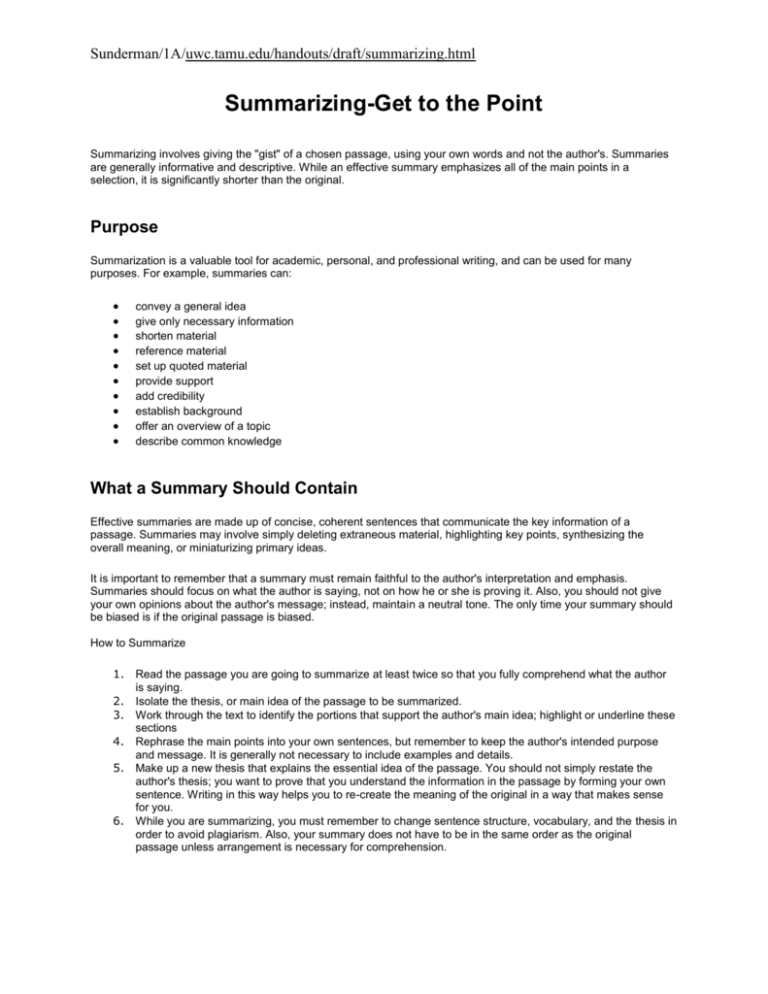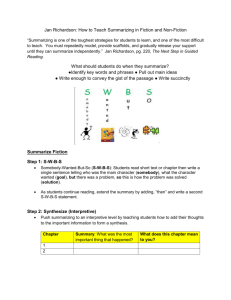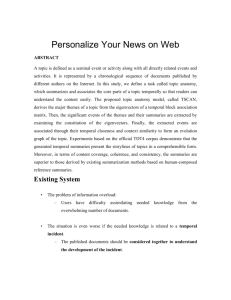Summarizing-Get to the Point
advertisement

Sunderman/1A/uwc.tamu.edu/handouts/draft/summarizing.html Summarizing-Get to the Point Summarizing involves giving the "gist" of a chosen passage, using your own words and not the author's. Summaries are generally informative and descriptive. While an effective summary emphasizes all of the main points in a selection, it is significantly shorter than the original. Purpose Summarization is a valuable tool for academic, personal, and professional writing, and can be used for many purposes. For example, summaries can: convey a general idea give only necessary information shorten material reference material set up quoted material provide support add credibility establish background offer an overview of a topic describe common knowledge What a Summary Should Contain Effective summaries are made up of concise, coherent sentences that communicate the key information of a passage. Summaries may involve simply deleting extraneous material, highlighting key points, synthesizing the overall meaning, or miniaturizing primary ideas. It is important to remember that a summary must remain faithful to the author's interpretation and emphasis. Summaries should focus on what the author is saying, not on how he or she is proving it. Also, you should not give your own opinions about the author's message; instead, maintain a neutral tone. The only time your summary should be biased is if the original passage is biased. How to Summarize 1. Read the passage you are going to summarize at least twice so that you fully comprehend what the author is saying. 2. Isolate the thesis, or main idea of the passage to be summarized. 3. Work through the text to identify the portions that support the author's main idea; highlight or underline these sections 4. Rephrase the main points into your own sentences, but remember to keep the author's intended purpose and message. It is generally not necessary to include examples and details. 5. Make up a new thesis that explains the essential idea of the passage. You should not simply restate the author's thesis; you want to prove that you understand the information in the passage by forming your own sentence. Writing in this way helps you to re-create the meaning of the original in a way that makes sense for you. 6. While you are summarizing, you must remember to change sentence structure, vocabulary, and the thesis in order to avoid plagiarism. Also, your summary does not have to be in the same order as the original passage unless arrangement is necessary for comprehension. Sunderman/1A/uwc.tamu.edu/handouts/draft/summarizing.html Checklist 1. 2. 3. 4. 5. Is the main idea clear and accurate? Is your summary concise? Are there few (if any) details and examples? Does your summary include only information found in the original? Does your summary read like a unified paragraph? Remember Always write a summary with the author's purpose in mind. The length of a summary depends on what is being summarized. Summarizing can always be improved with practice! Summarization Exercise Instructions: In groups, write a summary of one of the articles we have read so far. (I will assign an article to your group). Follow the steps for writing a summary highlighted above. Together, decide on the author’s main idea or thesis, and find the main points of the essay that should be highlighted. Then, write the summary, putting the author’s main idea and main points in your group’s own words. Choose one person to act as recorder, and another person to present the summary to the class. The class will discuss each summary. Has anything been left out? Is anything unclear? Were all necessary steps followed? Each group member, not just the presenter, should help defend or explain their summary. You should take notes on the other groups’ summaries. This exercise will allow you to leave this class with a clear understanding of each article we have read so far. It also provides practice, and will allow you to more effectively use summary in your writing assignments.









